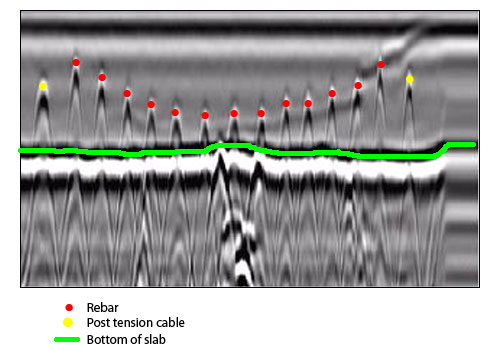Discover RainierGPR Service Areas Near You for Professional Concrete Scanning
Discover RainierGPR Service Areas Near You for Professional Concrete Scanning
Blog Article
Concrete Scanning: A Vital Step In The Direction Of Making Sure Architectural Honesty and Safety And Security
In the world of building and construction and infrastructure maintenance, the relevance of concrete scanning can not be overemphasized. By employing advanced innovation and techniques, concrete scanning offers as an essential tool in making sure that the stability and safety and security of bridges and buildings are promoted to the highest standards.
Importance of Concrete Scanning
Concrete scanning plays a vital duty in making sure the architectural integrity and security of structures and facilities tasks. By utilizing innovative technologies such as ground-penetrating radar (GPR) and electro-magnetic induction, specialists can non-destructively evaluate concrete frameworks to detect possible flaws, gaps, ingrained items, and support design. This procedure makes it possible for very early discovery of abnormalities that could compromise the stability of a structure, stopping costly damages and making sure the safety of passengers.
Prior to boring, reducing, or coring into concrete, scanning helps determine the exact places of rebar, post-tension cable televisions, and other ingrained components, reducing the risk of unintentional hits that could lead to architectural weak points. Additionally, concrete scanning aids in top quality control by confirming the thickness of concrete covers and discovering any discrepancies that might impact the overall resilience of the framework.
Modern Technology for Concrete Assessment

Advantages of Early Detection
Prompt detection of architectural problems can substantially mitigate dangers and make sure the long life of building jobs. By identifying prospective problems early in the construction process, stakeholders can take aggressive actions to deal with concerns before they escalate into larger and much more expensive issues. Among the vital advantages of very early discovery is the avoidance of architectural failings, which can posture serious security dangers and cause task hold-ups and economic losses.
Moreover, early detection enables timely repair services and upkeep, which can assist expand the life-span of the framework. By attending to problems quickly, construction teams can stay clear of pricey fixings or also the demand for early replacement of structural parts. This proactive method not just conserves money and time yet additionally boosts the overall safety and security and sturdiness of the building project.
In addition, very early detection can boost job planning and decision-making by giving stakeholders with useful insights right into the problem of the framework. Armed with this information, task managers can make enlightened options concerning building and construction approaches, timelines, and products, causing much more efficient and effective project end results.
Ensuring Architectural Security
Guaranteeing the structural stability of a building and construction job is paramount to its safety and security and durability. Architectural stability refers to the capacity of a building or framework to maintain its type and function under different lots and environmental problems. To attain this, complete assessment and tracking of the framework are important. Concrete scanning plays a crucial role in making certain architectural stability by discovering possible concerns useful site such as voids, delamination, or reinforcement rust that might endanger the honesty of the structure in time.
By utilizing sophisticated scanning technologies like ground-penetrating radar (GPR) and electromagnetic induction, building and construction experts can non-invasively check concrete frameworks to identify areas of worry web under the surface. This positive strategy allows for the very early discovery of weaknesses or problems, enabling prompt fixings or reinforcement to stop structural failings.
Normal concrete scanning throughout different construction stages and throughout the life process of a structure can help maintain its security, minimize risks, and ensure the safety and security of passengers. By prioritizing architectural stability with concrete scanning, building and construction tasks can enhance their resilience and toughness, inevitably adding to higher security and durability.

Protecting Against Essential Failures
To protect against catastrophic occasions, careful monitoring and proactive upkeep are critical in preventing crucial failings within architectural frameworks. Identifying prospective issues before they rise is crucial to avoiding structural failures. Executing routine examinations, such as concrete scanning, can disclose hidden defects like gaps, fractures, or rust that could jeopardize the honesty of a structure. By using advanced scanning technologies like Ground Permeating Radar (GPR) or Concrete X-ray, engineers can non-destructively examine the problem of concrete and identify powerlessness that need support or repair service - RainierGPR Service Areas.

Final Thought
To conclude, concrete scanning plays a vital duty in ensuring architectural integrity and safety and security by utilizing sophisticated innovation for early detection of prospective issues. This proactive strategy assists learn the facts here now prevent vital failures and makes sure the security of structures. It is vital to prioritize concrete assessment as a basic practice to protect the longevity and safety and security of structures and framework.
Concrete scanning plays an important role in guaranteeing the architectural honesty and safety of buildings and facilities projects. Additionally, concrete scanning help in quality control by verifying the thickness of concrete covers and detecting any kind of disparities that may affect the total longevity of the framework. Concrete scanning plays an important role in ensuring architectural stability by spotting possible problems such as voids, delamination, or support rust that could jeopardize the integrity of the framework over time.

In final thought, concrete scanning plays an essential duty in ensuring structural integrity and safety by utilizing advanced innovation for early detection of potential problems.
Report this page